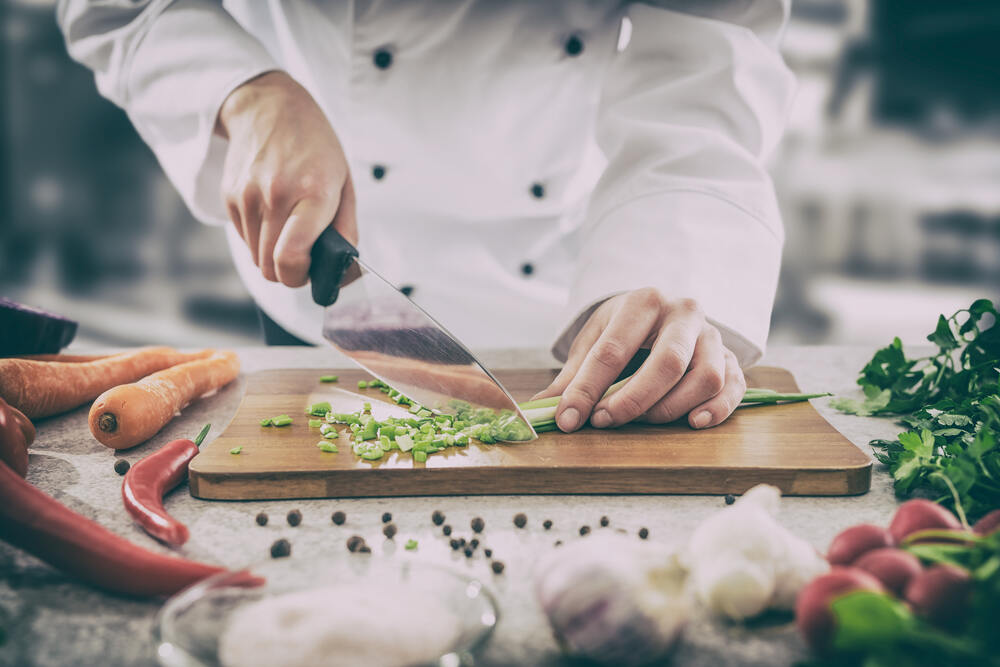The culinary world is all about efficiency. Efficiency of preparation. Efficiency of service. And what better tool to aid a professional chef than in the uniform they rely on day after day?
But look around a professional kitchen, and you’re likely to spy more than just one kind of uniform. In truth, a professional kitchen is hierarchical. Different functions and ranks, all indicated by the uniform that is worn (In some instances).
So, what are the different types of chef uniform options you may see in a professional culinary setting? Before we answer that, we first need to define the parts of a chef’s uniform.
Breaking Down the Parts of the Chef’s Uniform
There are four essential parts to a chef’s uniform. These are standards that, with some variety and panache, nearly every professional chef wears. These include:
- The Chef Hat – Headwear is essential in the kitchen to keep a chef’s hair from falling into the food they are preparing.
- The Chef Coat – A classic kitchen staple, though modern kitchens are easing on this tradition. (coats are becoming more stylish with materials aimed to cool the wearer and wick moisture away)
- The Culinary Pants – Different pant options abound. While traditionally, chefs wear a black and white houndstooth pant, colors, fabric, and texture variations are common. In many modern kitchens, the chef’s pant is typically in contrast with the color and/or pattern of their coat (these days the emphasis is on style, comfort and function, where even joggers and pants made with new materials are widely worn)
- The Chef Apron – A simple apron around the midsection completes the look.
Chefs uniforms also commonly feature slip-resistant shoes, though styles may vary from chef to chef.
Traditionally, the outfit is referred to as “chef’s whites.” However, many modern professional kitchens have incorporated different colors, materials, and patterns into a chef’s uniform. As the uniform is a means of distinguishing a chef, it is also a means for a restaurant to further brand itself, with the kitchen staff’s attire serving as an extension of the restaurant’s vibe.
For instance, while a very traditional restaurant may feature a traditional French-style uniform, with chef’s whites and toque blanche, a contemporary restaurant may use densely-inked fabrics, touches of contemporary fashion, and mixed materials to create a dynamic look.
When you compare those polar opposites with some kitchens, which allow the cook staff to bring their own sense of style into the kitchen, you can imagine how much the notion of a chef’s uniform has evolved since its inception.
Chef Attire Materials
The chef’s uniform is largely to ensure that those working in the kitchen are identifiable as such. Anyone wearing a uniform that is distinct from the front-of-house staff is likely kitchen staff, even to the untrained eye.
But the uniform serves another purpose as well. It is designed to protect the chef from the excess heat they work with all day long. Heavy duty cotton is the material of choice for the modern chef. It is a breathable fabric that is durable to stand up to licking flames.
Different Types of Chef Uniforms
The kitchen is largely segregated by function. Everyone knows their role and rarely crosses beyond its borders. And a uniform is designed to indicate that position. Here are the kitchen roles, along with the uniform pieces to match: (this is not true in all cases)
Executive Chef
This person is the top of heap, as far as the kitchen is concerned.
In traditional kitchens, they are most likely to be found wearing a toque blanche. This is the tall, pleated hat we’ve all seen in a million pop culture representations. However, in modern kitchens the toque blanche may be replaced by subtler flair. Often, small insignia, stitching, or embellishments are placed on the chef’s coat, apron, or shirt to differentiate them from the rest of the kitchen staff.
Chefs and Line Cooks
These middle-tier functions in the kitchen wear all of the standards (headwear, jacket, etc.). However, there may be individual differences per person based on the function they fill. For instance, a line cook working the frier may wear long sleeves to protect from oil spatter. Meanwhile, a saucier may be found with less protective attire.
Chefs and line cooks also wear headgear, though the range varies. In the modern kitchen, you can expect these staff to wear everything from bandanas to baseball caps, depending on the restaurant’s vibe.
Dishwashers & Garde Manger
The lowest rungs on the totem pole often feature the most utilitarian types of chef uniform. These workers might wear full-length aprons, coveralls, or other functional wear with the assumption of getting dirty.
In kitchens that are exposed to the dining room, however, these positions may don stylish outfits just like the rest of the cooking team. In these cases, aesthetics are everything, even if the look may be at odds with the task at hand.
Stunning and Functional Kitchen Uniforms
Regardless of what material and style your kitchen uniform comes in, the key is uniformity. Anything less, and your kitchen staff is at risk.
Every kitchen staff needs to look crisp, professional, and uniform in their presentation. And BlueCut Aprons is here to provide all of the pieces to make your chefs’ uniforms stand out. Shop our chef essentials.

